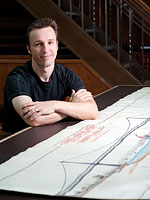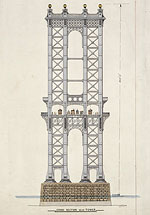
 First published in 2005, The Book Thief continues to be a phenomenal success both in Australia and overseas. It has been translated into over thirty languages, and has now sold more than three million copies worldwide. After more than three years since its international release, it is still on the New York Times bestseller list.
First published in 2005, The Book Thief continues to be a phenomenal success both in Australia and overseas. It has been translated into over thirty languages, and has now sold more than three million copies worldwide. After more than three years since its international release, it is still on the New York Times bestseller list.
Markus is currently working on a book titled Bridge of Clay – about a boy aspiring to greatness by building a bridge.
He still lives in Sydney, with his wife and daughter.
For me, though, the most exciting thing about the Mitchell Library is that you can come here looking for something specific and walk away with the unexpected. Last December, I was researching photos of the Harbour Bridge, and I came across this beautiful panoramic drawing of one of the bridges we might have had.
 The history of the bridge is so dramatic already, but I love the fact that we also had these alternative ideas for its design. For me, the attraction of that thought ties in with writing, and with the Mitchell Library itself. In any library, but particularly in the Mitchell (and at the risk of sounding a bit sentimental — but who cares?), so many ideas and possibilities are just waiting for us to discover them. I was originally looking for the photo of John Bradfield standing at the top of the open arch — one foot each side — but I was lucky enough to find this suspension bridge design instead. Even after seeing different plans in works like Peter Lalor’s excellent book, The Bridge, there was something special about looking at one of the original drawings. The thrill of a tangent swept me away. I was involved immediately in an alternate history. I was transported to another Sydney — to what might have been.
The history of the bridge is so dramatic already, but I love the fact that we also had these alternative ideas for its design. For me, the attraction of that thought ties in with writing, and with the Mitchell Library itself. In any library, but particularly in the Mitchell (and at the risk of sounding a bit sentimental — but who cares?), so many ideas and possibilities are just waiting for us to discover them. I was originally looking for the photo of John Bradfield standing at the top of the open arch — one foot each side — but I was lucky enough to find this suspension bridge design instead. Even after seeing different plans in works like Peter Lalor’s excellent book, The Bridge, there was something special about looking at one of the original drawings. The thrill of a tangent swept me away. I was involved immediately in an alternate history. I was transported to another Sydney — to what might have been.
In terms of writing, there is also a great deal of time spent planning and imagining, trying and failing. Beneath each book I’ve ever completed, there is every idea that didn’t survive. The irony, of course, is that this cavalcade of failed attempts and crooked moments is what gives the book its foundations. If a book is a bridge between writer and reader, it’s the countless pages of work that the reader doesn’t see that allows the crossing to take place. Often, there are also a few good ideas that just don’t make the cut, which makes me realise that sometimes a book’s worth might also be found in the quality of what we have to leave out.

Which brings me again to this drawing, and the questions surrounding it. Would Sydney still be Sydney with a suspension bridge, or a cantilever? What sort of nickname would we use instead of ‘The Old Coat Hanger’? What stories would stand in the place of the ones we treasure now? Whatever we imagine, this proposal paints a stunning picture of what might have been — but I also like to think it gives us an even greater appreciation of the incredible bridge we have.
Back to A Living Collection page